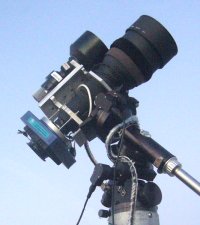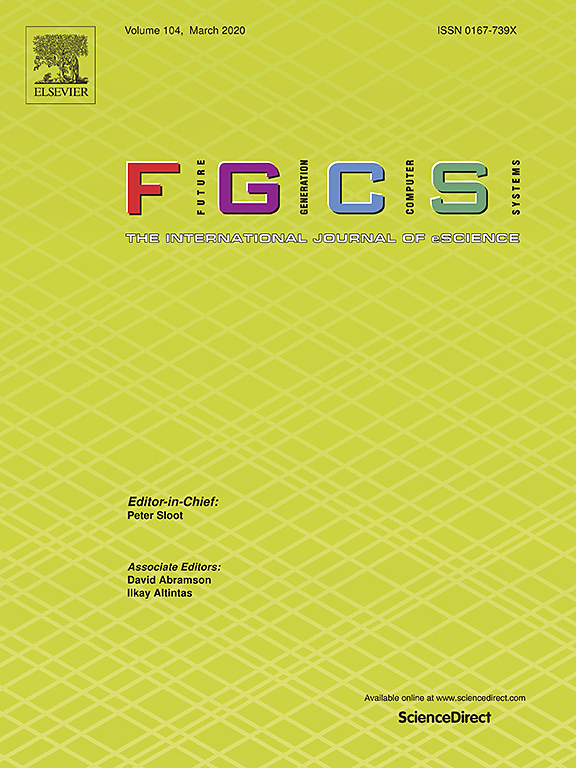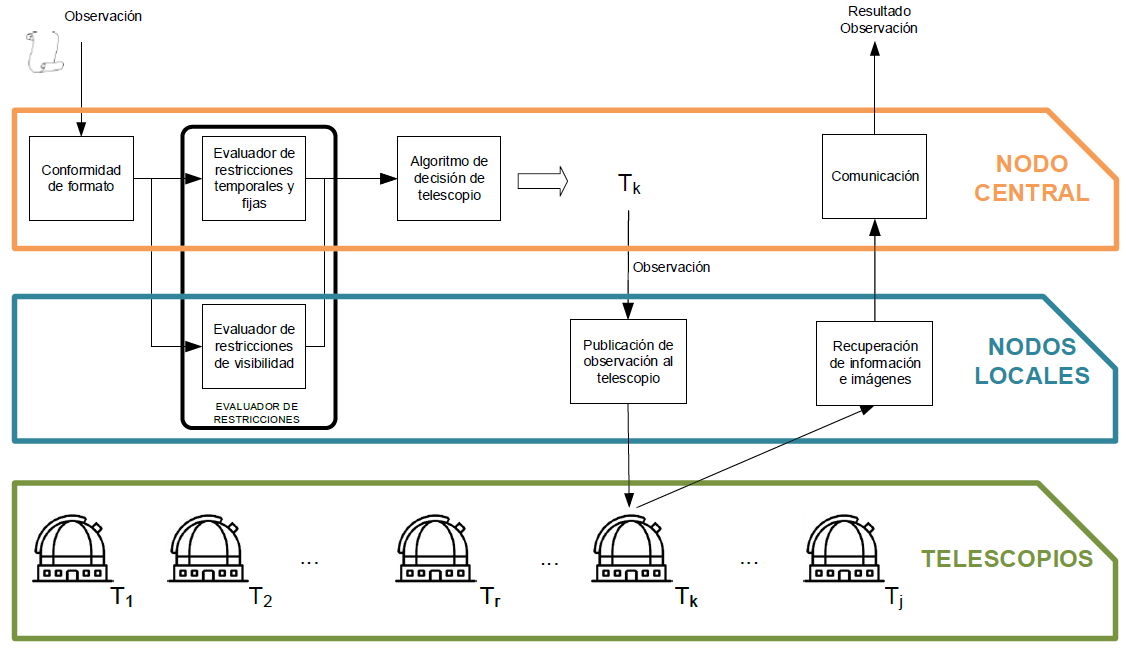Autonomous Astronomy
In the new era of multimessenger astronomy, autonomous observatories and telescope networks play a key role to follow-up fast astronomical events that would help to better understand the universe. On the other hand, space security is getting more and more attention since space debris and asteroids are becoming a threat for future space missions and Earth. In this sense, The Joint Research Unit (JRU) between the University of Málaga and the Institute of Astrophysics of Andalucia (CSIC) was created to accomplish the gap between astronomy, astrophysics and engineering. In particular, the JRU tries to join scientific contributions in the field of engineering and astrophysics, which would generate new discoveries. Most of the joint research is carried out using the BOOTES telescope network.
Projects:
 | Wide Field Optical System to follow-up transients and electromagnetic counterparts from gravitational waves (Andalusian Regional Government reference UMA18-FEDERJA-153) The main objective of this project is to develop a wide field optical instruments that allows, on the one hand, the immediate observation of Gamma Ray Bursts (GRBs) and its associated post-luminescence emission; and on the other hand, the detection of optical counterparts from gravitational waves sources (GWs). The project is conceived as a multidisciplinary one because it joins software and robotics with astrophysics. The aim is to obtain relevant results in both technological and scientific topics. Related to technology, it is mainly focused in the development of new methods to control and plan autonomous robotized telescopes. The main objective is to obtain astronomical images as fast as possible once an alert is received by the observatory. These alerts normally come from scientific satellites or gravitational waves interferometers. The images would be processed in real-time, allowing them to detect and confirm the cosmic origin of these alerts. As regards the scientific aspect, the objective is to observe both GRBs and GWs to find their corresponding optical counterparts in order to command bigger telescopes. It is worth mentioning some GRBs alerts are not processed because the error area is huge, i.e. several square degrees. Therefore, a wide field optical system is needed to solve this issue.Finally, the system to be developed will be used to support space mission from Earth, as well as it will be used in dissemination activities related to open science in high school and universities. An example is the ScienceIES project, in which high school students can use robotized telescopes in the joint research unit between the Institute of Astrophysics of Andalucia and the University of Malaga.
|
 | GLObal Robotic telescopes Intelligent Array (EU-FP7 grant agreement:283783) GLORIA is an innovative citizen-science network of robotic telescopes, which will give free access and research to a virtual community via the Internet. The GLORIA partners will offer access to a growing collection of robotictelescopes via a Web 2.0 environment - 17 telescopes on 4 continents by the project’s end. The GLORIA partners can do this because most of the telescopes are already robotized using the same free/open-source RTS2 software (maintained by GLORIA members), and the web access will be based onCiclope Astro (also by a GLORIA member), which currently provides the world’s first free-access robotic telescope at Montegancedo Observatory (http://om.fi.upm.es). The Internet experiments will be coordinated byGalaxy Zoo (http://galaxyzoo.org).The challenge will be to involve people from around the world, to maximise their collective intelligence,and to foster their participation in astronomy research both in data analysis and actual observations. Thee-Infrastructure will be managed using the method of ‘karma’, proven in most successful web 2.0 sites, wherebythose users who participate the most are awarded corresponding observing time.GLORIA will be an e-Science network for the virtual community, demonstrating how networking and opene-Infrastructures can increase the quality of research.During the project, 17 telescopes and 2 experiments will be deployed for these citizen scientists, and afoundation will be built up of documentation, free software, and a community of people will have grown, tomaintain and grow GLORIA into the future. Significant dissemination efforts will be made to draw in ordinarypeople, as well as scholars, to use the network, to learn about astronomy, and to do real science.Currently, GLORIA’s telescopes are individually supported from national funds and as this should continue, thenetwork will not bear the cost of their maintenance. GLORIA can easily survive in the future with minimal nationalfunding or even donations. |
Publications:
 | Observation of inverse Compton emission from a long γ-ray burst Peter Veres, PN Bhat, MS Briggs, WH Cleveland, R Hamburg, CM Hui, B Mailyan, ..., M.D. caballero-García, I.M. Carrasco, A. Castellón, N. Catro Segura, A.J. Castro-Tirado, ... , C.J. Pérez del Pulgar, ... Nature, 575, 459-463. Springer, 2019. |
| Long-duration γ-ray bursts (GRBs) originate from ultra-relativistic jets launched from the collapsing cores of dying massive stars. They are characterized by an initial phase of bright and highly variable radiation in the kiloelectronvolt-to-megaelectronvolt band, which is probably produced within the jet and lasts from milliseconds to minutes, known as the prompt emission1,2. Subsequently, the interaction of the jet with the surrounding medium generates shock waves that are responsible for the afterglow emission, which lasts from days to months and occurs over a broad energy range from the radio to the gigaelectronvolt bands1,2,3,4,5,6. The afterglow emission is generally well explained as synchrotron radiation emitted by electrons accelerated by the external shock7,8,9. Recently, intense long-lasting emission between 0.2 and 1 teraelectronvolts was observed from GRB 190114C10,11. Here we report multi-frequency observations of GRB 190114C, and study the evolution in time of the GRB emission across 17 orders of magnitude in energy, from 5 × 10−6 to 1012 electronvolts. We find that the broadband spectral energy distribution is double-peaked, with the teraelectronvolt emission constituting a distinct spectral component with power comparable to the synchrotron component. This component is associated with the afterglow and is satisfactorily explained by inverse Compton up-scattering of synchrotron photons by high-energy electrons. We find that the conditions required to account for the observed teraelectronvolt component are typical for GRBs, supporting the possibility that inverse Compton emission is commonly produced in GRBs.
| |
 | Observation scheduling and simulation in a global telescope network Carmen López-Casado, C.J. Pérez-del-Pulgar, Víctor F Muñoz, Alberto J Castro-Tirado Future Generation Computer Systems. 95, pp. 116 - 125. Elsevier, 2019.
|
The use of autonomous rovers for planetary exploration is crucial to traverse long distances and perform new discoveries on other planets. One of the most important issues is related to the interaction between the rover wheel and terrain, which would help to save energy and even avoid getting entrapped. The use of reconfigurable rovers with different locomotion modes has demonstrated improvement of traction and energy consumption. Therefore, the objective of this paper is to determine the best locomotion mode during the rover traverse, based on simple parameters, which would be obtained from propioceptive sensors. For this purpose, interaction of different terrains have been modelled and analysed with the ExoTeR, a scale prototype rover of the European ExoMars 2020 mission. This rover is able to perform, among others, the wheel walking locomotion mode, which has been demonstrated to improve traction in different situations. Currently, it is difficult to decide the instant time the rover has to switch from this locomotion mode to another. This paper also proposes a novel method to estimate the slip ratio, useful for deciding the best locomotion mode. Finally, results are obtained from an immersive simulation environment. It shows how each locomotion mode is suitable for different terrains and slopes and the proposed method is able to estimate the slip ratio. | |
 | GlSch: Planificación de Observaciones en la red de Telescopios GLORIA Revista Iberoamericana de Automática e Informática industrial. 2018 Apr 18. |
Este artículo propone el diseño y desarrollo de un planificador para la red de telescopios GLORIA. Esta red, cuyo principal objetivo es acercar los ciudadanos a la astronomía, está formada por 18 telescopios ubicados en cuatro continentes. Parte de la gestión de esta red se lleva a cabo por el planificador, que se encarga de recibir peticiones de observación de usuarios de usuarios y enviárselas a uno de los telescopios de la red. Para esto, necesita un algoritmo que decida el mejor telescopio, evitando ofrecer una petición a un telescopio que finalmente no pueda ejecutarla. Este artículo presenta dos algoritmos de decisión: el primero se basa únicamente en la predicción meteorológica, y el segundo emplea lógica difusa e información de cada telescopio. Ambos algoritmos fueron implantados en la red GLORIA. Los resultados obtenidos, así como una comparativa del rendimiento de ambos se presenta en este artículo. Así mismo, se detalla la arquitectura del planificador basada en una estructura híbrida distribuida-centralizada. | |
 | Multi-messenger Observations of a Binary Neutron Star Merger Benjamin P Abbott, Richard Abbott, TD Abbott, F Acernese, K Ackley, C Adams, ... ,
|
| |
 | Localization and broadband follow-up of the gravitational-wave transient GW150914 Benjamin P Abbott, R Abbott, TD Abbott, MR Abernathy, F Acernese, K Ackley, ... , The Astrophisical Journal Letters, 826 - 1, American Astronomical Society 2016 July 20. |
| A gravitational-wave (GW) transient was identified in data recorded by the Advanced Laser Interferometer Gravitational-wave Observatory (LIGO) detectors on 2015 September 14. The event, initially designated G184098 and later given the name GW150914, is described in detail elsewhere. By prior arrangement, preliminary estimates of the time, significance, and sky location of the event were shared with 63 teams of observers covering radio, optical, near-infrared, X-ray, and gamma-ray wavelengths with ground- and space-based facilities. In this Letter we describe the low-latency analysis of the GW data and present the sky localization of the first observed compact binary merger. We summarize the follow-up observations reported by 25 teams via private Gamma-ray Coordinates Network circulars, giving an overview of the participating facilities, the GW sky localization coverage, the timeline, and depth of the observations. As this event turned out to be a binary black hole merger, there is little expectation of a detectable electromagnetic (EM) signature. Nevertheless, this first broadband campaign to search for a counterpart of an Advanced LIGO source represents a milestone and highlights the broad capabilities of the transient astronomy community and the observing strategies that have been developed to pursue neutron star binary merger events. Detailed investigations of the EM data and results of the EM follow-up campaign are being disseminated in papers by the individual teams. | |
 | W Zheng, RF Shen, T Sakamoto, AP Beardmore, M De Pasquale, XF Wu, J Gorosabel, Y Urata, S Sugita, B Zhang, A Pozanenko, M Nissinen, DK Sahu, M Im, TN Ukwatta, M Andreev, E Klunko, A Volnova, CW Akerlof, P Anto, SD Barthelmy, A Breeveld, U Carsenty, S Castillo-Carrión, AJ Castro-Tirado, MM Chester, CJ Chuang, R Cunniffe, A De Ugarte Postigo, R Duffard, H Flewelling, N Gehrels, T Güver, S Guziy, VP Hentunen, KY Huang, M Jelínek, TS Koch, P Kubánek, P Kuin, TA McKay, S Mottola, SR Oates, P O'Brien, M Ohno, MJ Page, SB Pandey, C Pérez del Pulgar, W Rujopakarn, E Rykoff, T Salmi, R Sánchez-Ramírez, BE Schaefer, A Sergeev, E Sonbas, A Sota, JC Tello, K Yamaoka, SA Yost, F Yuan The Astrophysical Journal. 751 - 2, American Astronomical Society, 2012. |
| We present a comprehensive analysis of a bright, long-duration (T 90 ~ 257 s) GRB 110205A at redshift z = 2.22. The optical prompt emission was detected by Swift/UVOT, ROTSE-IIIb, and BOOTES telescopes when the gamma-ray burst (GRB) was still radiating in the γ-ray band, with optical light curve showing correlation with γ-ray data. Nearly 200 s of observations were obtained simultaneously from optical, X-ray, to γ-ray (1 eV to 5 MeV), which makes it one of the exceptional cases to study the broadband spectral energy distribution during the prompt emission phase. In particular, we clearly identify, for the first time, an interesting two-break energy spectrum, roughly consistent with the standard synchrotron emission model in the fast cooling regime. Shortly after prompt emission (~1100 s), a bright (R = 14.0) optical emission hump with very steep rise (α ~ 5.5) was observed, which we interpret as the reverse shock (RS) emission. It is the first time that the rising phase of an RS component has been closely observed. The full optical and X-ray afterglow light curves can be interpreted within the standard reverse shock (RS) + forward shock (FS) model. In general, the high-quality prompt and afterglow data allow us to apply the standard fireball model to extract valuable information, including the radiation mechanism (synchrotron), radius of prompt emission (R GRB ~ 3 × 1013 cm), initial Lorentz factor of the outflow (Γ0 ~ 250), the composition of the ejecta (mildly magnetized), the collimation angle, and the total energy budget. | |



